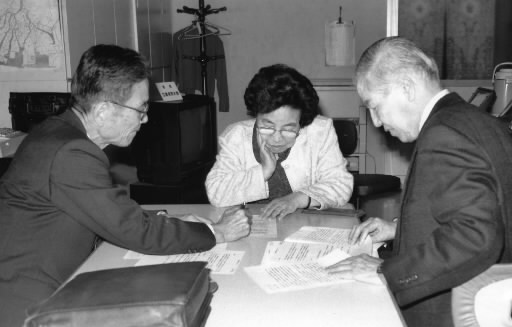My Life: Interview with Sunao Tsuboi, Chairperson of the Japan Confederation of A- and H-Bomb Sufferers Organizations, Part 11
Feb. 4, 2013
Banner
by Sakiko Masuda, Staff Writer
Continued call for state compensation
In 1993, several years after he retired as a junior high school principal, Mr. Tsuboi became deputy director of the Hiroshima Prefectural Confederation of A-bomb Sufferers Organizations (Hidankyo) led by Ichiro Moritaki (1901-1994).
A mutual friend of Mr. Moritaki’s told me that the deputy director was in poor health and asked if I’d take over the job. That friend was Akira Ishida (1928-2003), who was chair of the A-bombed Teachers Association of Japan. We had been friends ever since we first met at a peace education workshop when I was a teacher.
I was going to ask for a little time to think it over, but then he said the general meeting was the next day. I said, “Be serious! I’ve taught peace education, but I’ve never participated in a movement like that.” He said, “You’re an A-bomb survivor, aren’t you?” I decided to do it.
I had talked to groups about my A-bomb experiences, but I was a former school administrator. Other people must have thought I was some sort of politician. I wasn’t a long-time member of Hidankyo, so I was at a loss at first. It was completely different from schools. After I became deputy director, I scrambled to study Hidankyo’s history.
In July 1994 Mr. Tsuboi assumed the post of deputy director. In December of that year a relief law, which had been the earnest desire of the atomic bomb survivors, was enacted.
State compensation, an essential element, was omitted. Although the state had started the war, only former servicemen and other military personnel were to receive compensation. Compensation for the families of those who had died in the atomic bombings was not included. Legislators as well as ordinary citizens felt that since a relief law had been passed, A-bomb survivors should quit complaining. The government’s stance was, “It was a war, so just live with your problems.” In order to overturn this notion of “endurance,” we had to keep speaking out to get state compensation, not only for victims of the A-bombings but also the victims of air raids.
As a result of a schism in the ban-the-bomb movement, Hidankyo split into two groups. Kazushi Kaneko, 87, became chair of the other organization. Starting in 1997, the chairs of the two groups began attending the other’s general meeting.
Mr. Kaneko had been a teacher too, and we were friends. At the time, there was criticism from within that the organization was being sold out. As a result of the split, our influence was weakened in some ways, but we couldn’t have worked together with the distrust that existed between us. Even if we can’t integrate the two groups, we need to join hands in the areas in which we can cooperate.
(Originally published on January 30, 2013)
by Sakiko Masuda, Staff Writer
Continued call for state compensation
In 1993, several years after he retired as a junior high school principal, Mr. Tsuboi became deputy director of the Hiroshima Prefectural Confederation of A-bomb Sufferers Organizations (Hidankyo) led by Ichiro Moritaki (1901-1994).
A mutual friend of Mr. Moritaki’s told me that the deputy director was in poor health and asked if I’d take over the job. That friend was Akira Ishida (1928-2003), who was chair of the A-bombed Teachers Association of Japan. We had been friends ever since we first met at a peace education workshop when I was a teacher.
I was going to ask for a little time to think it over, but then he said the general meeting was the next day. I said, “Be serious! I’ve taught peace education, but I’ve never participated in a movement like that.” He said, “You’re an A-bomb survivor, aren’t you?” I decided to do it.
I had talked to groups about my A-bomb experiences, but I was a former school administrator. Other people must have thought I was some sort of politician. I wasn’t a long-time member of Hidankyo, so I was at a loss at first. It was completely different from schools. After I became deputy director, I scrambled to study Hidankyo’s history.
In July 1994 Mr. Tsuboi assumed the post of deputy director. In December of that year a relief law, which had been the earnest desire of the atomic bomb survivors, was enacted.
State compensation, an essential element, was omitted. Although the state had started the war, only former servicemen and other military personnel were to receive compensation. Compensation for the families of those who had died in the atomic bombings was not included. Legislators as well as ordinary citizens felt that since a relief law had been passed, A-bomb survivors should quit complaining. The government’s stance was, “It was a war, so just live with your problems.” In order to overturn this notion of “endurance,” we had to keep speaking out to get state compensation, not only for victims of the A-bombings but also the victims of air raids.
As a result of a schism in the ban-the-bomb movement, Hidankyo split into two groups. Kazushi Kaneko, 87, became chair of the other organization. Starting in 1997, the chairs of the two groups began attending the other’s general meeting.
Mr. Kaneko had been a teacher too, and we were friends. At the time, there was criticism from within that the organization was being sold out. As a result of the split, our influence was weakened in some ways, but we couldn’t have worked together with the distrust that existed between us. Even if we can’t integrate the two groups, we need to join hands in the areas in which we can cooperate.
(Originally published on January 30, 2013)








